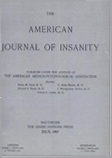A STATISTICAL STUDY OF HALLUCINATIONS IN THE MANIC-DEPRESSIVE PSYCHOSES
Abstract
A statistical study of hallucinations in 1009 cases of manicdepressive psychoses with 1408 cases of schizophrenia and 496 cases of general paresis as controls leads to the following conclusions:
Hallucinations are absent in 70 per cent of the males and 63 per cent of the females in the manic-depressive group as compared with 25 per cent of the males and 19 per cent of the females in schizophrenia, and 73 per cent of the males and 58 per cent of the females in general paresis.
The most common type of hallucinations which occur in the manic-depressive psychoses is the auditory type, which is present in 16 per cent of the males and 18 per cent of the females. Auditory hallucinations likewise appear most frequently in schizophrenia, there being 50 per cent of the males and 56 per cent of the females having such hallucinations. The incidence of auditory hallucinations in general paresis is nearly the same as in the manicdepressive psychoses.
Visual hallucinations are the next most common type of hallucination to occur in all three groups. In the manic-depressive psychoses 7 per cent of the males and 11 per cent of the females have visual hallucinations; in schizophrenia 18 per cent of the males and 24 per cent of the females have visual hallucinations, while in general paresis the percentages are again quite close to those occurring in the manic-depressive psychoses, there being 6 per cent of the males and 18 per cent of the females having visual hallucinations.
Tactile, olfactory, gustatory and somatic hallucinations are quite rare, there being less than 1 per cent of each in the manicdepressive psychoses and in the males with general paresis. In schizoprenia the somatic hallucinations are the most common, being present in 3 per cent of the males and 4 per cent of the females.
The close relationship between hallucinations in the manicdepressive psychoses and general paresis seems of considerable interest, since in a previous paper' we have pointed out the same tendency with regard to delusions.
Sex appears to play a role in the development of hallucinations, since in all three psychoses, females have more cases showing hallucinations than do males. This sex difference is most striking with regard to the visual type of hallucinations.
In an endeavor to determine what other factors besides diagnosis and sex might determine the presence of hallucinations, or the type of hallucinations, detailed two-way association tables were made for each sex and diagnosis, showing the relationship between hallucinations and each of the following conditions: (1) Marital condition, (2) Age at admission, (3) Birthplace of patient, (4) Religion, (5) Personality traits, (6) Intelligence, (7) Somatic data, (8) Delusions, (9) Duration of attack previous to admission, (10) Previous attacks, (11) Alcoholic habits, (12) White blood count.
Marital condition has nothing to do with the number or type of hallucinations occurring in any of the three psychoses. Age, likewise, shows nothing of significance. Birthplace of the patient does not affect the development of hallucinations in any way. Religion has no influence on the development of hallucinations.
The pre-psychotic personality seems to show several significant associations between types of personality and the number and types of hallucinations. Manic-depressive females of seclusive personality show a significant tendency to develop auditory and visual hallucinations. Males, however, show nothing significant. In the schizophrenic group females with sexually unbalanced personalities show a greater tendency to develop visual hallucinations.
Intelligence has no effect on the number or types of hallucinations developed. The occurrence of definite physical findings, likewise, has no effect upon the number or types of hallucinations.
There is considerable association between delusions and hallucinations; in all three groups there is a positive association between no delusions and no hallucinations and unknown delusions and unknown hallucinations. The most striking association is between persecutory delusions and auditory hallucinations which show a positive association in all groups except schizophrenic females.
The duration of attack appears to have little to do with the occurrence of hallucinations, the only significant association being that more hallucinations than would be expected are found among manic-depressive females where the attack was of less than 31 days.
The occurrence of a previous attack has no effect upon the development of hallucinations.
Alcoholic habits have little effect upon the occurrence of hallucinations, but in the schizophrenic males there is a positive association between visual hallucinations and intemperate alcoholic habits. Males in the other two diagnoses show a tendency toward this association.
The presence of a high white blood count has no effect upon the occurrence of hallucinations.
Access content
To read the fulltext, please use one of the options below to sign in or purchase access.- Personal login
- Institutional Login
- Sign in via OpenAthens
- Register for access
-
Please login/register if you wish to pair your device and check access availability.
Not a subscriber?
PsychiatryOnline subscription options offer access to the DSM-5 library, books, journals, CME, and patient resources. This all-in-one virtual library provides psychiatrists and mental health professionals with key resources for diagnosis, treatment, research, and professional development.
Need more help? PsychiatryOnline Customer Service may be reached by emailing [email protected] or by calling 800-368-5777 (in the U.S.) or 703-907-7322 (outside the U.S.).



